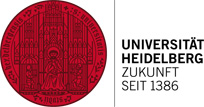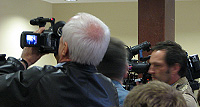The Codex Manesse and the Discovery of Love
Heidelberg University Library exhibits priceless medieval manuscript in the original

It was in the Hohenstaufen era that European literature turned its attention to the subject of courtly love, thus sparking off one of the most complex societal discourses of the time. The exhibition “The Codex Manesse and the Discovery of Love” is Heidelberg University Library’s contribution to the University’s upcoming 625th anniversary celebrations. The exhibit reveals the way in which the debate about ideal love is reflected in the written testimonies of the High Middle Ages. To mark the occasion, the Library will be exhibiting the famous Codex Manesse in the original, one of the rare occasions on which this magnificent collection of songs and verses in Middle High German will leave the air-conditioned environs of the library’s vault. The approximately 100 exhibits on show also include many other valuable manuscripts. The exhibition runs until 20 February 2011.
The Codex Manesse came into being in Zurich in the early 14th century, probably at the behest of Rüdiger Manesse and his son Johann. Their ambition was to assemble a representative collection of Middle High German lyric poetry reflecting its full range of genres and forms. The manuscript encompasses the work of 140 poets, with the earliest texts dating back to the mid 12th century. The Codex is one of the key testimonies to the literature and culture of the Hohenstaufen era. The poems are preceded by a total of 138 miniatures, idealised depictions of their authors going about their courtly activities. "Saget mir ieman, waz ist minne?" (Can anyone tell me what love is?) In the High Middle Ages, this concern with the true nature of love, voiced here by poet Walther von der Vogelweide, preoccupied itinerant troubadours, nobles and clerics alike. Countless texts and pictures tell us that a major change of attitude had come about. A knight was no longer content to possess the lady who took his fancy. He was out to conquer her heart. The onset of this many-voiced, idealistic approach to love not only changed relations between the sexes, it also transformed aristocratic identity and the conduct of affairs in courtly society. The poems and pictures in the Codex Manesse embody and epitomise this sea change in medieval social attitudes.

The exhibition traces the discovery of love in the High Middle Ages as it is exemplified in the Codex Manesse and other valuable manuscripts and prints from the vaults of Heidelberg University Library. Most of the exhibits are lavishly illustrated, thus also giving the viewer a glimpse into German book illustration techniques between the 13th and the 15th century. A number of the most significant works of the Middle Ages are on show, for example Wolfram von Eschenbach’s "Parzival". In the course of the exhibition, the pages of the Codex Manesse will be turned four times to present different miniatures to the public.
The exhibition is divided into four sections. The first two are devoted to the origins and impact of the Codex and its transmission down the centuries. The third revolves around “The Discovery of Courtly Love”. The literature that began to flourish in the second half of the 12th century heralds in something sensationally new. At the courts of secular princes, poetry was no longer written in the scholarly Latin of the church but in Middle High German. Quite new was the idea of love that reigned supreme in both the epic and lyric poetry of the day. The subject of the fourth section is "The Power of Love". The dealings between knights and ladies called for in the ongoing discourse on courtly love take the form of an art based on complicated rules that first have to be mastered.

Picture material: Heidelberg University Library
The University Library and Heidelberg University welcomed guests in the Great Hall of the Old University to the opening of the exhibition on Monday, 25 October 2010. There were speeches of welcome from Prof. Dr. Friederike Nüssel, Vice Rector of Heidelberg University, and the Director of the Library, Dr. Veit Probst. In the lecture at the heart of the ceremony, Prof. Dr. Ludger Lieb of the Department of German Studies spoke on "The Idea of Love. Text and Image in the Codex Manesse". Subsequently, Dr. Carla Meyer of the Institute of Franconian-Palatinate History and Area Studies outlined the concept on which the exhibition is based. In the course of the evening there were also musical interludes from Ilan Bendahan Bitton performing piano music by Bach and Beethoven.
The exhibition "The Codex Manesse and the Discovery of Love" will be open to the public at Heidelberg University Library until 20 February 2011 every day from 10 a.m. to 6 p.m. It will be closed on national or state holidays and on 2 January. The admission fee is 5 euros (reduced 3 euros). Groups of between 8 and 15 persons will be charged 40 euros. There are guided tours of the exhibition every Saturday from 2 p.m. A further option is participation in a tour of the Old Town including the exhibition (Saturdays from 11 a.m.). Individual group tours can be arranged via Heidelberg Marketing, phone: +49 6221 142223 or 142225, e-mail: guide@heidelberg.de.
The exhibition is a major contribution to the programme of events with which Heidelberg University presents itself to the public in its 625th anniversary year from October 2010 to October 2011. It also stands in close conjunction with the large-scale exhibition "The Hohenstaufen Dynasty and Italy" at the Reiss-Engelhorn- Museen Mannheim. The Codex Manesse exhibit was made possible by collaboration between the Institute of Franconian-Palatine History and Area Studies, the Department of German Studies, Heidelberg University Library and a group of committed students from Heidelberg University’s Department of History. A virtual tour of the exhibition is available at http://manesse2010.uni-hd.de.
Note for editors:
Digital photos are available from the Press Office.

